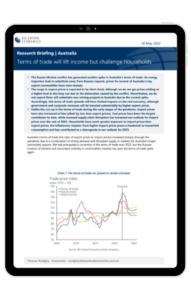Terms of trade will lift income but challenge Australian households
 The Russia-Ukraine conflict has generated another spike in Australia’s terms of trade. As energy importers look to substitute away from Russian exports, prices for several of Australia’s key export commodities have risen sharply. The surge in export prices is expected to be short-lived, although we do see gas prices settling at a higher level in the long-run due to the dislocation caused by the conflict.
The Russia-Ukraine conflict has generated another spike in Australia’s terms of trade. As energy importers look to substitute away from Russian exports, prices for several of Australia’s key export commodities have risen sharply. The surge in export prices is expected to be short-lived, although we do see gas prices settling at a higher level in the long-run due to the dislocation caused by the conflict.
Nevertheless, we do not expect firms will undertake new mining projects in Australia due to the current spike. Accordingly, this terms of trade episode will have limited impacts on the real economy, although government and corporate revenues will be boosted substantially by higher export prices.
What you will learn:
- Australia’s terms of trade (the ratio of export prices to import prices) increased sharply through the pandemic due to a combination of strong demand and disrupted supply in markets for Australia’s major commodity exports.
- The reduction in supply has seen large spikes in energy and food prices – both of which make up a large share of Australia’s exports. Simultaneously, expectations for steel production in China have increased, boosting demand for iron ore and coking coal and driving up prices.
- We expect the peak in these price cycles will be short lived, although the dislocation in energy markets is expected to keep oil prices well above previous expectations for some years ahead.
Tags:
Related posts

Post
Navigating Australia’s Labour Market
Explore July's labour market update: unemployment dips to 4.2%, showing stability despite economic challenges. Learn how these trends may impact the future.
Find Out More
Post
Understanding Australia’s Goods Trade Dynamics in 2025
2. Explore Australia's goods trade dynamics, with rising exports and falling imports. Learn how global demand impacts the trade balance and future projections.
Find Out More
Post
Households open their wallets as an August rate cut looms in Australia
Household spending rose in June, driven by EOFY sales, but subdued per capita growth and labour market softness reinforce expectations of an RBA rate cut.
Find Out More